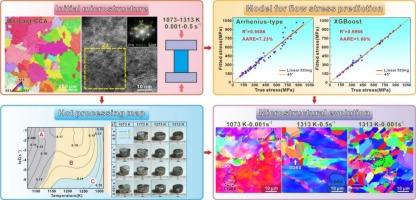l12强化Co33Cr23Ni34Al5Ti5化学复合合金本构建模的机器学习辅助优化及热变形显微组织研究
IF 5.5
2区 材料科学
Q1 MATERIALS SCIENCE, CHARACTERIZATION & TESTING
引用次数: 0
摘要
为了解决化学复杂合金(CCAs)的强度-塑性平衡问题,多步热机械加工,特别是热变形,是优化显微组织的关键策略。热变形控制动态再结晶(DRX)行为,使非均质组织和析出相得以调节。研究了温度和应变速率对l12增强Co33Cr23Ni34Al5Ti5 CCAs变形行为和显微组织演变的影响。动态材料模型导出的加工图确定了1313 K和0.001 s−1为最佳加工窗口,并通过微观结构观察进行了验证。此外,开发了一种先进的极端梯度增强(XGBoost)辅助机器学习(ML)模型,与传统的本构模型相比,显示出更高的预测精度。在低应变速率下,温度升高诱导了从主导DRX机制到不连续DRX (DDRX)到DDRX和连续DRX (CDRX)耦合机制的转变。相反,高温下较高的应变率会削弱CDRX。此外,L12纳米沉淀物的存在通过钉住位错和阻碍亚晶界运动有效地控制了再结晶晶粒的生长,从而导致微观组织的细化。这些发现为优化热机械加工提供了重要见解,为设计具有定制微结构的先进l12强化cca提供了途径。本文章由计算机程序翻译,如有差异,请以英文原文为准。

Machine-learning-assisted optimization of constitutive modeling and microstructural insights into the hot deformation of L12-strengthened Co33Cr23Ni34Al5Ti5 chemically complex alloys
To tackle the strength-ductility trade-off in chemically complex alloys (CCAs), multi-step thermo-mechanical processing, particularly hot deformation, is a key strategy for optimizing microstructures. Hot deformation controls dynamic recrystallization (DRX) behaviors, enabling the regulation of heterogeneous structures and precipitated phases. This study investigates the influence of temperature and strain rate on the deformation behavior and microstructural evolution of L12-strengthened Co33Cr23Ni34Al5Ti5 CCAs. The dynamic materials model-derived processing map determines 1313 K and 0.001 s−1 as the optimal processing window, validated by microstructural observations. Moreover, an advanced eXtreme Gradient Boosting (XGBoost)-assisted machine learning (ML) model is developed, demonstrating superior predictive accuracy compared to traditional constitutive models. At low-strain rates, increasing temperature induces the transition from the dominant DRX mechanism to discontinuous DRX (DDRX) to a coupled DDRX and continuous DRX (CDRX) regime. Conversely, higher strain rates at elevated temperatures weaken CDRX. Additionally, the presence of L12 nanoprecipitates effectively controls recrystallized grain growth by pinning dislocations and impeding subgrain boundary movement, leading to microstructure refinement. These findings offer critical insights for optimizing thermo-mechanical processing, providing a pathway to design advanced L12-strengthened CCAs with tailored microstructures.
求助全文
通过发布文献求助,成功后即可免费获取论文全文。
去求助
来源期刊

Materials Characterization
工程技术-材料科学:表征与测试
CiteScore
7.60
自引率
8.50%
发文量
746
审稿时长
36 days
期刊介绍:
Materials Characterization features original articles and state-of-the-art reviews on theoretical and practical aspects of the structure and behaviour of materials.
The Journal focuses on all characterization techniques, including all forms of microscopy (light, electron, acoustic, etc.,) and analysis (especially microanalysis and surface analytical techniques). Developments in both this wide range of techniques and their application to the quantification of the microstructure of materials are essential facets of the Journal.
The Journal provides the Materials Scientist/Engineer with up-to-date information on many types of materials with an underlying theme of explaining the behavior of materials using novel approaches. Materials covered by the journal include:
Metals & Alloys
Ceramics
Nanomaterials
Biomedical materials
Optical materials
Composites
Natural Materials.
 求助内容:
求助内容: 应助结果提醒方式:
应助结果提醒方式:


